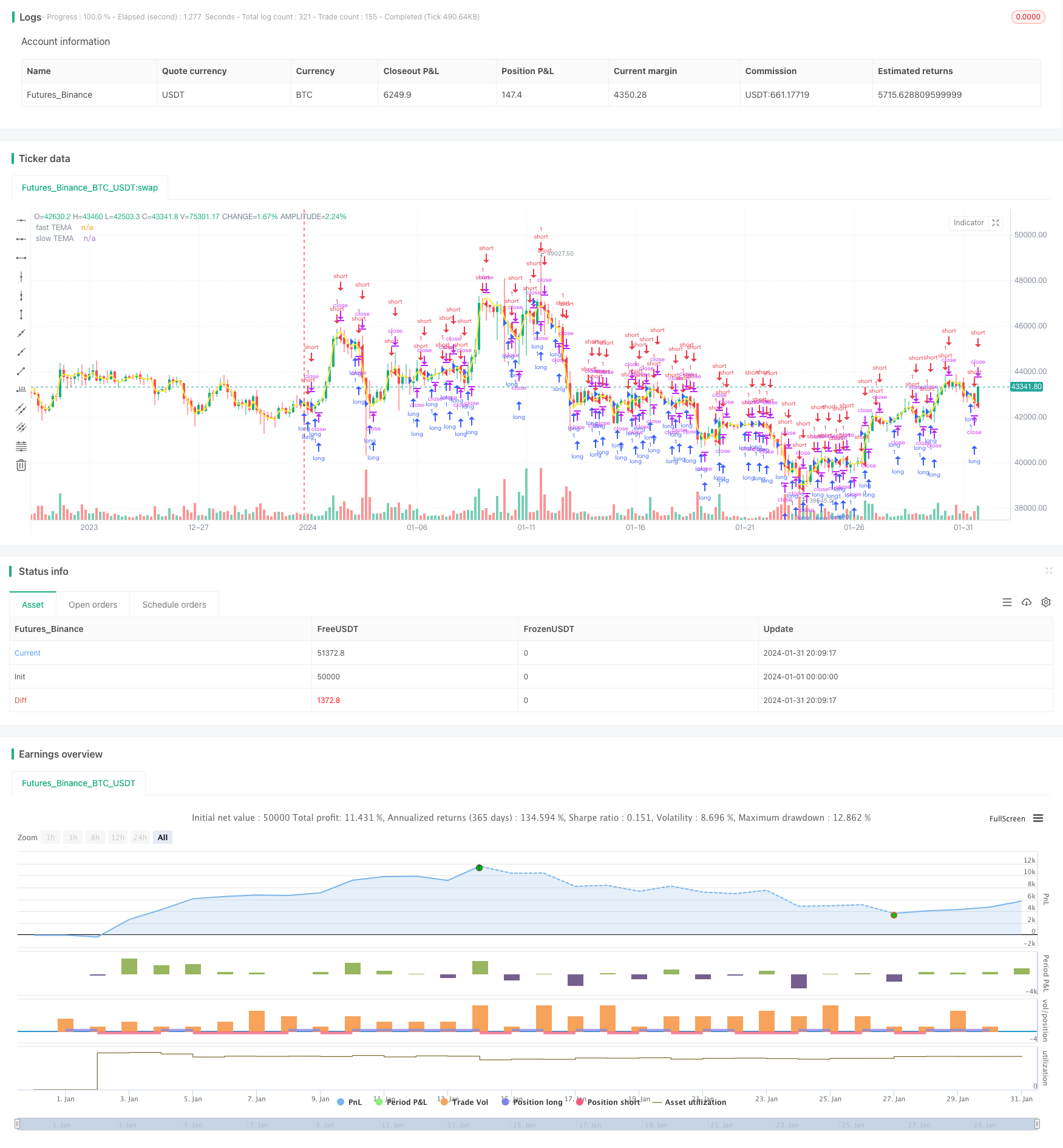
概述
本策略基于动量指标矩形通道和双均线指标,实现了一个较为完整的股票交易系统。策略首先使用快速EMA和慢速EMA构建双均线交易信号。然后结合矩形通道指标进一步验证交易信号,实现更准确的入场。此外,策略还使用了SAR指标来辅助判断趋势方向。
策略原理
计算快速EMA周期5日和慢速EMA周期50日的均线。快速EMA反映最近价格变化,慢速EMA反映长期趋势。
将EMA转换为TEMA(三重指数移动平均线),利用TEMA的加权计算方法,提高曲线的灵敏度,更快捕捉价格变化。
当快速TEMA上穿慢速TEMA时产生买入信号;当快速TEMA下穿慢速TEMA时产生卖出信号。双均线交叉原理被广泛应用于量化交易。
计算价格通道宽度,形成通道区域。只有当价格突破通道才考虑发出交易信号。这可以过滤假信号,验证真正趋势的开始。
SAR指标判断整体趋势方向,与双均线交易信号组合使用,可以避免不必要的反向操作。
策略优势
双均线交叉结合通道突破,可以有效识别趋势的开始,过滤噪音,使买卖信号更加准确可靠。
TEMA曲线比EMA曲线更加灵敏,可以更快速捕捉价格变化。
多种指标组合使用,可以形成指标间的验证机制,避免单一指标的局限性,使策略更加全面和稳健。
策略参数设置灵活,EMA周期、通道宽度等都可以根据市场行情进行调整优化,适应性强。
策略风险
股价短期内存在剧烈波动的概率,容易引发止损。
突发事件导致股价出现缺口,无法按预期价格成交。
双均线交叉并不能完全避免假信号的出现,仍有一定的误判率。
参数设置不当可能导致过于频繁或滞后的交易信号。
优化方向
可以结合更多指标,如KD、MACD等进行验证,使策略更加全面可靠。
可以设置动态周期,根据市场波动程度来调整EMA 和通道参数,使策略更加灵活。
可以建立机器学习模型,训练大量历史数据,自动优化参数设置,减少人工干预。
可以结合文本分析、新闻情感等判断市场气氛,避免在重大消息发布时无谓交易。
总结
本策略通过快慢TEMA均线交叉形成交易信号,再结合价格通道和SAR指标进行验证,可以有效识别股价趋势的开始,在合理位置进行买卖操作。多种指标组合互相验证,可以提高信号的可靠性,是一种较为稳健和高效的股票交易策略。通过不断优化参数设置、增加新的验证指标等手段,策略的效果还可继续改进。
/*backtest
start: 2024-01-01 00:00:00
end: 2024-01-31 23:59:59
period: 4h
basePeriod: 15m
exchanges: [{"eid":"Futures_Binance","currency":"BTC_USDT"}]
*/
//@version=2
strategy("TEMA_System_SAR", overlay=true)
//Collect inputs parameters
fastEmaPeriod = input(5, minval=1, title="Fast TEMA Period")
slowEmaPeriod = input(50, minval=1, title="Slow TEMA Periods")
// === INPUT BACKTEST RANGE ===
FromMonth = input(defval = 1, title = "From Month", minval = 1, maxval = 12)
FromDay = input(defval = 4, title = "From Day", minval = 1, maxval = 31)
FromYear = input(defval = 2010, title = "From Year", minval = 2000)
ToMonth = input(defval = 1, title = "To Month", minval = 1, maxval = 12)
ToDay = input(defval = 1, title = "To Day", minval = 1, maxval = 31)
ToYear = input(defval = 9999, title = "To Year", minval = 2000)
// === FUNCTION EXAMPLE ===
start = timestamp(FromYear, FromMonth, FromDay, 09, 15) // backtest start window
finish = timestamp(ToYear, ToMonth, ToDay, 15, 30) // backtest finish window
window() => true
fastEma = ema(close, fastEmaPeriod)
slowEma = ema(close, slowEmaPeriod)
//convert EMA into TEMA
ema1 = ema(close, fastEmaPeriod)
ema2 = ema(ema1, fastEmaPeriod)
ema3 = ema(ema2, fastEmaPeriod)
fastTEMA = 3 * (ema1 - ema2) + ema3
// convert EMA into TEMA
ema4 = ema(close, fastEmaPeriod)
ema5 = ema(ema1, fastEmaPeriod)
ema6 = ema(ema2, fastEmaPeriod)
slowTEMA = 3 * (ema4 - ema5) + ema6
buy = close > fastTEMA
sell = close < fastTEMA
plot(fastTEMA, title = 'fast TEMA', linewidth=2, color=white)
plot(slowTEMA, title = 'slow TEMA', linewidth=2, color=yellow)
strategy.entry("long",strategy.long, when = window() and buy)
strategy.entry("short", strategy.short, when = window() and sell)